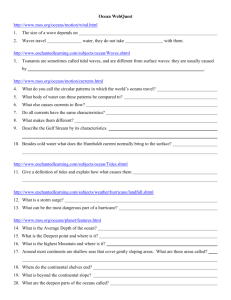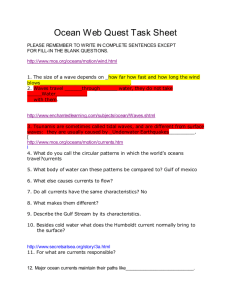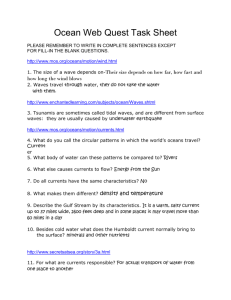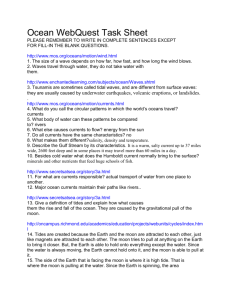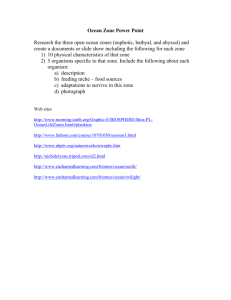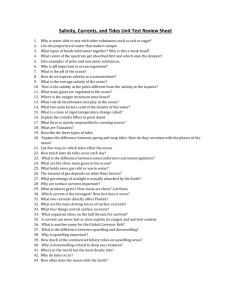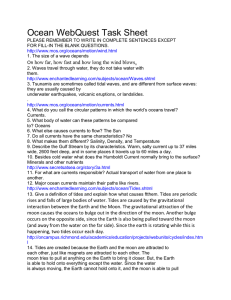Ocean WebQuest Task Sheet
advertisement
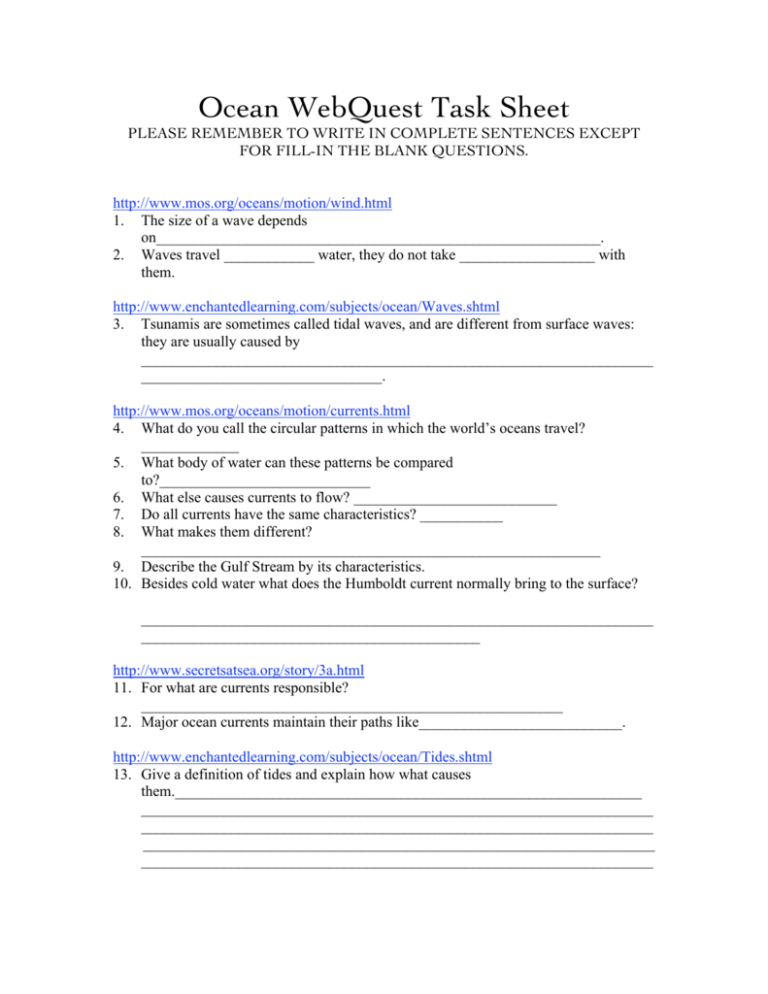
Ocean WebQuest Task Sheet PLEASE REMEMBER TO WRITE IN COMPLETE SENTENCES EXCEPT FOR FILL-IN THE BLANK QUESTIONS. http://www.mos.org/oceans/motion/wind.html 1. The size of a wave depends on___________________________________________________________. 2. Waves travel ____________ water, they do not take __________________ with them. http://www.enchantedlearning.com/subjects/ocean/Waves.shtml 3. Tsunamis are sometimes called tidal waves, and are different from surface waves: they are usually caused by ____________________________________________________________________ ________________________________. http://www.mos.org/oceans/motion/currents.html 4. What do you call the circular patterns in which the world’s oceans travel? _____________ 5. What body of water can these patterns be compared to?____________________________ 6. What else causes currents to flow? ___________________________ 7. Do all currents have the same characteristics? ___________ 8. What makes them different? _____________________________________________________________ 9. Describe the Gulf Stream by its characteristics. 10. Besides cold water what does the Humboldt current normally bring to the surface? ____________________________________________________________________ _____________________________________________ http://www.secretsatsea.org/story/3a.html 11. For what are currents responsible? ________________________________________________________ 12. Major ocean currents maintain their paths like___________________________. http://www.enchantedlearning.com/subjects/ocean/Tides.shtml 13. Give a definition of tides and explain how what causes them.______________________________________________________________ ____________________________________________________________________ ____________________________________________________________________ ____________________________________________________________________ ____________________________________________________________________ http://oncampus.richmond.edu/academics/education/projects/webunits/cycles/index.html 14. Tides are created because the Earth and the moon are _____________ _____ __________ _________, just like __________ are attracted to each other. The moon tries to pull at anything on the ______ to bring it __________. But, the Earth is able to hold onto everything ____________ ____ ___________. Since the water is always moving, the Earth cannot ______ onto it, and the moon is able to ______ at it. 15. The side of the Earth that is facing the moon is where it is _________ tide. That is where the moon is ___________ at the water. Since the Earth is _________, the area that the moon is pulling at changes. That is why the tides _________. If you are at the beach, and the moon is pulling on the ocean there, it will be ________ tide. If the moon is pulling at the ocean somewhere else, then it will be _____ tide at the beach where you are. 16. How do we know that the water nearest to the moon forms a bulge? ___________________________________________________________________ ____________________________________________________________________ __________________________________________________________________ 17. Where else does the water form a bulge? __________________________________________________________________ 18. How many tides are there each day? ___________________________________ 19. How much time is there between tides? _______________________ http://www.enchantedlearning.com/subjects/weather/hurricane/landfall.shtml 20. What is a storm surge? ___________________________________________________________________ ____________________________________________________________________ 21. What can be the most dangerous part of a hurricane? __________________________________________ http://www.geophys.washington.edu/tsunami/movies/globe.mov (tsunami movie) http://www.lacoast.gov/education/FragileFringe/barriers.htm 21. Although barrier islands, called spits in the northeastern United States, exist on all coastlines, the are most notable along the Gulf of Mexico and Atlantic coasts. They are the structures resulting from the movement of ____________ by __________ and the ____________. The seaward side of a barrier island is usually a sandy, beach-like area. This area ___________and ___________ in size with changes in seasonal _________ and ________ ________ which carries sand into and away from the sandy shore. 22. Use your newfound knowledge (and your textbook) to construct a chart on white computer paper. This chart should have four components: waves, tides, currents and storms. In each section describe how that type of water movement shapes the shore and include an illustration of each as well. http://www.ocean.udel.edu/extreme2002/ 23. Dive in mission to the abyss: go to seafloor geology then click on the Quicktime video to see a real undersea volcano. Click on The Deep Ocean, Mid-Ocean Ridge, Plate Tectonics and Hydrothermal Vents. Pay attention and take notes on things you’d like to include in your model of the ocean floor. Remember your model should include: continental shelf/rise/slope, mid-Atlantic ridges, rifts and trenches. http://projects.edtech.sandi.net/valencia/explore/ocean_layers.html 24. Sketch the diagram at this site to help you in building your ocean floor model. http://www.enchantedlearning.com/subjects/astronomy/planets/earth/Continents.shtml 25. You have been given two diagrams. Read the definitions then label the outer layers of the Earth and the seafloor spreading (plate divergence) diagrams. http://www.enchantedlearning.com/subjects/astronomy/activities/radiobuttonquiz/Tectoni cspz.shtml 26. Take this on-line quiz about plate tectonics. Record your score here ____________. http://www.amnh.org/nationalcenter/expeditions/blacksmokers/gallery.html 27. At this site view underwater photos and video clips from ocean floor volcanoes called smokers. Which of the three videos is best. Fully describe what is happening in the video you selected as being best. http://www.windows.ucar.edu/tour/link=/earth/interior/plate_tectonics.html 28. This picture shows how the rigid outer layer of the Earth, called the _______________________, is made of plates which fit together like a jigsaw puzzle. 29. Of what are these plates made? _____________________ 30. What allows the plates to "float" on top of the denser material? ___________________________________________________________________ _______________________________________________________________ http://www.mos.org/oceans/planet/features.html 31. What is the Average Depth of the ocean? ____________________________________________________ 32. What is the Deepest point and where is it? ___________________________________________________ 33. What is the highest Mountain and where is it? _______________________________________________ 34. Around most continents are shallow seas that cover gently sloping areas. What are these areas called?_______________________________________________ ______________________________________________________________ 35. Where do the continental shelves end? ___________________________________________________________________ 36. What is beyond the continental slope? ___________________________________ 37. Describe the abyss in a complete paragraph. __________________________________________________________________ ____________________________________________________________________ ____________________________________________________________________ ____________________________________________________________________ ____________________________________________________________________ ____________________________________________________________________ 38. What are the deepest parts of the oceans called? ____________________________________________________________________
